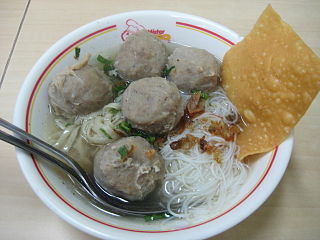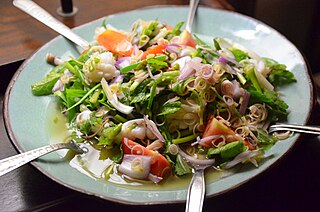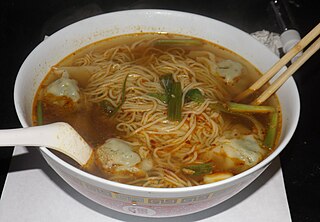
Chow mein are Chinese stir-fried noodles with vegetables and sometimes meat or tofu; the name is a romanization of the Taishanese chāu-mèing. The dish is popular throughout the Chinese diaspora and appears on the menus of most Chinese restaurants abroad. It is particularly popular in India, Nepal, the UK, and the US.

Malaysian cuisine consists of cooking traditions and practices found in Malaysia, and reflects the multi-ethnic makeup of its population. The vast majority of Malaysia's population can roughly be divided among three major ethnic groups: Malays, Chinese and Indians. The remainder consists of the indigenous peoples of Sabah and Sarawak in East Malaysia, the Orang Asli of Peninsular Malaysia, the Peranakan and Eurasian creole communities, as well as a significant number of foreign workers and expatriates.

Indonesian cuisine is a collection of various regional culinary traditions that formed the archipelagic nation of Indonesia. There are a wide variety of recipes and cuisines in part because Indonesia is composed of approximately 6,000 populated islands of the total 17,508 in the world's largest archipelago, with more than 300 ethnic groups calling Indonesia home. Many regional cuisines exist, often based upon indigenous culture with some foreign influences. Indonesia has around 5,350 traditional recipes, with 30 of them considered the most important. Indonesia's cuisine may include rice, noodle and soup dishes in modest local eateries to street-side snacks and top-dollar plates.

Malaysian Chinese cuisine is derived from the culinary traditions of Chinese Malaysian immigrants and their descendants, who have adapted or modified their culinary traditions under the influence of Malaysian culture as well as immigration patterns of Chinese to Malaysia. Because the vast majority of Chinese Malaysians are descendants of immigrants from southern China, Malaysian Chinese cuisine is predominantly based on an eclectic repertoire of dishes with roots from Fujian, Cantonese, Hakka and Teochew cuisines.

Noodle soup refers to a variety of soups with noodles and other ingredients served in a light broth. Noodle soup is common dish across East and Southeast Asia. Various types of noodles are used, such as rice noodles, wheat noodles and egg noodles.

Chinese Indonesian cuisine is characterized by the mixture of Chinese with local Indonesian style. Chinese Indonesians brought their legacy of Chinese cuisine, and modified some of the dishes with the addition of Indonesian ingredients, such as kecap manis, palm sugar, peanut sauce, chili, santan and local spices to form a hybrid Chinese-Indonesian cuisine. Some of the dishes and cakes share the same style as in Malaysia and Singapore which are known as the Nonya cuisine by the Peranakan.

Fried noodles are common throughout East and Southeast Asia. Many varieties, cooking styles, and ingredients exist.

Peranakan cuisine or Nyonya cuisine comes from the Peranakans, descendants of early Chinese migrants who settled in Penang, Malacca, Singapore and Indonesia, inter-marrying with local Malays. In Baba Malay, a female Peranakan is known as a nonya, and a male Peranakan is known as a baba. The cuisine combines Chinese, Malay and other influences.

Bakmi consists of two Hokkien Chinese words literally translated to English as "meat noodles". Bakmi is a wheat based noodle which was brought to Indonesian archipelago by Hokkien Chinese immigrants from Fujian, generally prepared and topped with minced pork seasoned in soy sauce and A few slices of char siu (叉燒) or barbecued pork, with addition of Chinese green vegetables and a bowl of broth.

Mie goreng, also known as bakmi goreng, is an often spicy fried noodle dish, originating from Indonesia, common in Malaysia, Brunei Darussalam, and Singapore. It is made with thin yellow noodles fried in cooking oil with garlic, onion or shallots, fried prawn, chicken, beef, or sliced bakso (meatballs), chili, Chinese cabbage, cabbages, tomatoes, egg, and other vegetables. Ubiquitous in Indonesia, it is sold by food vendors from street-hawkers, warungs, to high-end restaurants. It is an Indonesian one-dish meal favourite, although street food hawkers commonly sell it together with nasi goreng. It is commonly available at Mamak stalls in Singapore, Brunei Darussalam, and Malaysia and is often spicy. In Sri Lanka, mee goreng is a popular dish due to Malay cultural influences and is sold at street food stalls around the country.

Bakso or baso is an Indonesian meatball, or a meat paste made from beef surimi. Its texture is similar to the Chinese beef ball, fish ball, or pork ball. The word bakso may refer to a single meatball or the complete dish of meatball soup. Mie bakso refers to bakso served with yellow noodles and rice vermicelli, while bakso kuah refers to bakso soup served without noodles.

Yi mein is a variety of flat Cantonese egg noodles made from wheat flour. They are known for their golden yellow color and chewy characteristics. The slightly chewy and slightly spongy texture of the noodles is due to the soda water used in making the dough, which is then fried and dried into flat patty-like dried bricks.

Lontong is an Indonesian dish made of compressed rice cake in the form of a cylinder wrapped inside a banana leaf, commonly found in Indonesia, Malaysia and Singapore. Rice is rolled inside a banana leaf and boiled, then cut into small cakes as a staple food replacement of steamed rice. The texture is similar to those of ketupat, with the difference being that the ketupat container is made from weaved janur fronds, while lontong uses banana leaf instead.

Sundanese cuisine is the cuisine of the Sundanese people of West Java, Indonesia. It is one of the most popular foods in Indonesia. Sundanese food is characterised by its freshness; the famous lalab eaten with sambal and also karedok demonstrate the Sundanese fondness for fresh raw vegetables. Unlike the rich and spicy taste, infused with coconut milk and curry of Minangkabau cuisine, the Sundanese cuisine displays the simple and clear taste; ranged from savoury salty, fresh sourness, mild sweetness, to hot and spicy.

Malaysian Indian cuisine, or the cooking of the ethnic Indian communities in Malaysia consists of adaptations of authentic dishes from India, as well as original creations inspired by the diverse food culture of Malaysia. Because the vast majority of Malaysia's Indian community are of South Indian descent, and are mostly ethnic Tamils who are descendants of immigrants from a historical region which consists of the modern Indian state of Tamil Nadu and Sri Lanka's Northern Province, much of Malaysian Indian cuisine is predominantly South Indian inspired in character and taste. A typical Malaysian Indian dish is likely to be redolent with curry leaves, whole and powdered spice, and contains fresh coconut in various forms. Ghee is still widely used for cooking, although vegetable oils and refined palm oils are now commonplace in home kitchens. Before a meal it is customary to wash hands as cutlery is often not used while eating, with the exception of a serving spoon for each respective dish.

Kwetiau goreng is a Chinese Indonesian stir fried flat rice noodle dish from Indonesia and popular in Southeast Asia. This flavorful and spicy fried noodle dish is common in Indonesia. It is made from noodles, locally known as kwetiau, which are stir fried in cooking oil with garlic, onion or shallots, beef, chicken, fried prawn, crab or sliced bakso (meatballs), chili, Chinese cabbage, cabbages, tomatoes, egg, and other vegetables with an ample amount of kecap manis. In Asia, kwetiau is available in two forms, dried and fresh. Its recipe is quite similar with another Chinese Indonesian favourite, mie goreng, with the exception of replacing yellow wheat noodles for flat rice noodles.

Mie ayam, mi ayam or bakmi ayam is a common Indonesian dish of seasoned yellow wheat noodles topped with diced chicken meat (ayam). It especially common in Indonesia, Singapore and Malaysia, and can trace its origin to Chinese cuisine. In Indonesia, the dish is recognized as a popular Chinese Indonesian dish, served from simple travelling vendor carts frequenting residential areas, humble street-side warung to restaurants.

Salads that are internationally known as Thai salads, with a few exceptions, fall into four main methods of preparation. In Thai cuisine these are called yam, tam, lap and phla. A few additional dishes can also be regarded as being a salad.

Wonton noodles (pinyin: Yúntūn miàn; Cantonese Yale: wàhn tān mihn, also called wanton mee or wanton mein is a Cantonese noodle dish Wonton noodles were not given their name, húntún, until the Tang Dynasty. The dish is popular in Southern China, Hong Kong, Indonesia, Malaysia, Singapore and Thailand. The dish is usually served in a hot broth, garnished with leafy vegetables and wonton dumplings. The types of leafy vegetables used are usually kai-lan, also known as Chinese kale. Another type of dumpling known as shui jiao is sometimes served in place of wonton. It contains prawns, chicken or pork, and spring onions, with some chefs adding mushroom and black fungus. In Indonesia wonton noodles are called mie pangsit.

Seblak is a Southeast Asian savoury and spicy dish, originating from Indonesia, made of wet krupuk cooked with protein sources in spicy sauce. Seblak is a specialty of Bandung city, West Java, Indonesia. Seblak can be acquired from restaurants, warungs or gerobak (cart) street vendors. It is one of the most popular street foods in Indonesia, especially in Bandung and Jakarta.



















